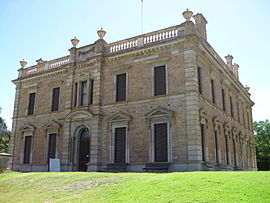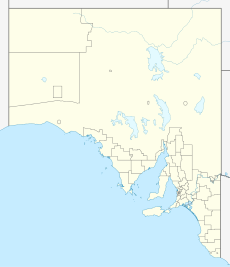Mintaro, South Australia
|
Mintaro South Australia |
|||||||||||||
|---|---|---|---|---|---|---|---|---|---|---|---|---|---|

The iconic Martindale Hall
|
|||||||||||||
| Coordinates | 33°55′S 138°43′E / 33.917°S 138.717°ECoordinates: 33°55′S 138°43′E / 33.917°S 138.717°E | ||||||||||||
| Population | 223 (2006 census)(2006 Census) | ||||||||||||
| Established | 1854 | ||||||||||||
| Postcode(s) | 5415 | ||||||||||||
| Location | |||||||||||||
| LGA(s) | District Council of Clare and Gilbert Valleys | ||||||||||||
| Region | Mid North | ||||||||||||
| State electorate(s) | Frome | ||||||||||||
| Federal Division(s) | Wakefield | ||||||||||||
|
|||||||||||||
Mintaro is an historic town in the eastern Clare Valley, about 128 km north of Adelaide, South Australia. The town lies at the south-eastern corner of the Hundred of Clare, and is pronounced "min-TAIR-oh" by the locals. The entire town of Mintaro was declared a State Heritage Area for South Australia in 1984.
Europeans explored the Mintaro district in mid-1839, firstly John Hill and then Edward John Eyre. The first European settler was pastoralist James Stein who from 1841 held occupation licences for extensive sheep runs stretching from Mount Horrocks through Farrell Flat to the Burra district.
Stein established his homestead on a tributary of the Wakefield River, in a vale beneath Mount Horrocks, about three kilometres west of present Mintaro, naming it Kadlunga, Aboriginal for 'sweet hills' after the abundant honeysuckle there. In following decades, with a succession of owners, Kadlunga Station became a famed sheep and horse stud. The historic stone buildings of the Kadlunga Estate are listed on the Register of the National Estate.
The town was founded in 1854 by Joseph and Henry Gilbert on land purchased by Henry Gilbert in July 1849.
Originally, and for several years, Mintaro was a busy watering stop for throngs of bullock teams travelling the Gulf Road between the copper mining town of Burra and Port Wakefield, transporting copper and coal for the Patent Copper Company.
In mid-1852, as a result of the Victorian Gold Rush, most of these teams and wagons abruptly lay idle for want of teamsters. In desperation the Patent Copper Company imported mule teams from South America and up to a hundred mules were seen to pass though the town each day. The town’s economy collapsed when the teams where rerouted to the new railhead at Gawler from 1857, but soon recovered with the growth of slate quarrying and agricultural production. The town now has tourism as its current primary industry. When the railway from Gawler was later extended through to Burra, the Mintaro railway station was 7 kilometres (4.3 mi) east of the town.
...
Wikipedia

